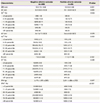1. Committee on Practice Bulletins—Obstetrics. Practice bulletin no. 180: gestational diabetes mellitus. Obstet Gynecol. 2017; 130:e17–e37.
2. Jang HC. Clinical studies of gestational diabetes mellitus. J Korean Diabetes Assoc. 1996; 20:336–347.
3. Jiwani A, Marseille E, Lohse N, Damm P, Hod M, Kahn JG. Gestational diabetes mellitus: results from a survey of country prevalence and practices. J Matern Fetal Neonatal Med. 2012; 25:600–610.

4. Koo BK, Lee JH, Kim J, Jang EJ, Lee CH. Prevalence of gestational diabetes mellitus in Korea: a National Health Insurance Database study. PLoS One. 2016; 11:e0153107.

5. Cho GJ, An JJ, Choi SJ, Oh SY, Kwon HS, Hong SC, et al. Postpartum glucose testing rates following gestational diabetes mellitus and factors affecting testing non-compliance from four tertiary centers in Korea. J Korean Med Sci. 2015; 30:1841–1846.

6. American Diabetes Association. Gestational diabetes mellitus. Diabetes Care. 2004; 27:Suppl 1. S88–S90.
7. Rosenstein MG, Cheng YW, Snowden JM, Nicholson JM, Doss AE, Caughey AB. The risk of stillbirth and infant death stratified by gestational age in women with gestational diabetes. Am J Obstet Gynecol. 2012; 206:309.e1–309.e7.

8. Alberico S, Erenbourg A, Hod M, Yogev Y, Hadar E, Neri F, et al. Immediate delivery or expectant management in gestational diabetes at term: the GINEXMAL randomised controlled trial. BJOG. 2017; 124:669–677.

9. Caughey AB, Valent AM. When to deliver women with diabetes in pregnancy? Am J Perinatol. 2016; 33:1250–1254.
10. Mitanchez D. Fetal and neonatal complications of gestational diabetes: perinatal mortality, congenital malformations, macrosomia, shoulder dystocia, birth injuries, neonatal outcomes. J Gynecol Obstet Biol Reprod (Paris). 2010; 39:S189–S199.
11. Neff KJ, Walsh C, Kinsley B, Daly S. Serial fetal abdominal circumference measurements in predicting normal birth weight in gestational diabetes mellitus. Eur J Obstet Gynecol Reprod Biol. 2013; 170:106–110.

12. Quevedo SF, Bovbjerg ML, Kington RL. Translation of fetal abdominal circumference-guided therapy of gestational diabetes complicated by maternal obesity to a clinical outpatient setting. J Matern Fetal Neonatal Med. 2017; 30:1450–1455.

13. Landon MB, Spong CY, Thom E, Carpenter MW, Ramin SM, Casey B, et al. A multicenter, randomized trial of treatment for mild gestational diabetes. N Engl J Med. 2009; 361:1339–1348.

14. Statistics Korea. Complementary investigations on the infant, maternal, and perinatal mortality [Internet]. Daejeon (KR): Statistics Korea;2016. cited 2017 May 10. Available from:
http://kostat.go.kr.
15. Kim MJ, Lee SK, Lee JA, Lee PR, Park HS. Risk factors for gestational diabetes mellitus in Korean women. Korean J Obes. 2013; 22:85–93.

16. Cho GJ, Kim LY, Sung YN, Kim JA, Hwang SY, Hong HR, et al. Secular trends of gestational diabetes mellitus and changes in its risk factors. PLoS One. 2015; 10:e0136017.

17. Lee JM, Kim MJ, Kim MY, Han JY, Ahn HK, Choi JS, et al. Gestational weight gain is an important risk factor for excessive fetal growth. Obstet Gynecol Sci. 2014; 57:442–447.

18. Di Cianni G, Volpe L, Lencioni C, Miccoli R, Cuccuru I, Ghio A, et al. Prevalence and risk factors for gestational diabetes assessed by universal screening. Diabetes Res Clin Pract. 2003; 62:131–137.

19. Heude B, Thiebaugeorges O, Goua V, Forhan A, Kaminski M, Foliguet B, et al. Pre-pregnancy body mass index and weight gain during pregnancy: relations with gestational diabetes and hypertension, and birth outcomes. Matern Child Health J. 2012; 16:355–363.

20. Park JS, Kim DW, Kwon JY, Park YW, Kim YH, Cho HY. Development of a screening tool for predicting adverse outcomes of gestational diabetes mellitus: a retrospective cohort study. Medicine (Baltimore). 2016; 95:e2204.
21. Park JH, Song HJ, Choun JK, Cho JJ, Paek YJ, Park KH, et al. Risk factors for gestational diabetes mellitus. Korean J Obes. 2005; 14:178–185.
22. Schaefer-Graf UM, Kjos SL, Fauzan OH, Buhling KJ, Siebert G, Buhrer C, et al. A randomized trial evaluating a predominantly fetal growth-based strategy to guide management of gestational diabetes in Caucasian women. Diabetes Care. 2004; 27:297–302.
23. Gopinath S, Varalakshmi G, Manoj K. Rubiya. Glycemic control and fetal abdominal circumference. Indian J Endocrinol Metab. 2012; 16:S445–S446.
24. International Association of Diabetes and Pregnancy Study Groups Consensus Panel. International association of diabetes and pregnancy study groups recommendations on the diagnosis and classification of hyperglycemia in pregnancy. Diabetes Care. 2010; 33:676–682.
25. Bobrowski RA, Bottoms SF, Micallef JA, Dombrowski MP. Is the 50-gram glucose screening test ever diagnostic? J Matern Fetal Med. 1996; 5:317–320.

26. Cheng YW, Esakoff TF, Block-Kurbisch I, Ustinov A, Shafer S, Caughey AB. Screening or diagnostic: markedly elevated glucose loading test and perinatal outcomes. J Matern Fetal Neonatal Med. 2006; 19:729–734.

27. Cha HH, Kim JY, Choi SJ, Oh SY, Roh CR, Kim JH. How high is too high in cutoff levels from 50-g glucose challenge test. Obstet Gynecol Sci. 2016; 59:178–183.

28. Metzger BE, Coustan DR. Summary and recommendations of the Fourth International Workshop-Conference on Gestational Diabetes Mellitus. The Organizing Committee. Diabetes Care. 1998; 21:Suppl 2. B161–B167.









 PDF
PDF ePub
ePub Citation
Citation Print
Print



 XML Download
XML Download